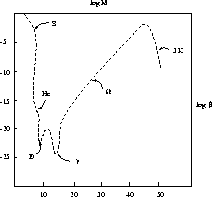




Next: Appendix
Up: Primordial Black Holes
Previous: About Black Hole
An important feature about black hole was proved by Hawking [22].
Black hole emit radiation and therefore are not really black. They radiate high energy particles; they evaporate.
The evaporation time (in seconds) is given by  where M is in g (like always for that kind of data).
To evaporate now, a primordial black hole
must have a mass of
where M is in g (like always for that kind of data).
To evaporate now, a primordial black hole
must have a mass of  . There is no particular reason for a black hole to evaporate now but if one does, then we will be able to observe it. This will give a lot of data on black holes and also for high energy particle physics.
. There is no particular reason for a black hole to evaporate now but if one does, then we will be able to observe it. This will give a lot of data on black holes and also for high energy particle physics.
As a result of that evaporation we can have a lot of observable effect of black hole.
Then constraint on black hole mass come from very various observations such as the microwave background , entropy production ... This lead to a very complete set of constraints that you can see in the table 

Table: Constraint on the mass spectrum of primordial black hole.
A good way to visualize how all the result from the different sets of data can be put together is shown in the figure  (for more detail about it see [29]).
(for more detail about it see [29]).

Figure: Upper limit on  the fraction of the universe that form primordial black hole
of that mass from different kind of measurement. M is normalized to gramme
the fraction of the universe that form primordial black hole
of that mass from different kind of measurement. M is normalized to gramme
In that figure there are data from the measurement of the total density parameter  , the
, the  -ray background, the primordial helium He and Deuterium D abundances and the photon-to-baryon ratio S.
-ray background, the primordial helium He and Deuterium D abundances and the photon-to-baryon ratio S.
Peggy Varniere
Fri Jul 24 11:57:38 EDT 1998
 where M is in g (like always for that kind of data).
To evaporate now, a primordial black hole
must have a mass of
where M is in g (like always for that kind of data).
To evaporate now, a primordial black hole
must have a mass of  . There is no particular reason for a black hole to evaporate now but if one does, then we will be able to observe it. This will give a lot of data on black holes and also for high energy particle physics.
. There is no particular reason for a black hole to evaporate now but if one does, then we will be able to observe it. This will give a lot of data on black holes and also for high energy particle physics.


 the fraction of the universe that form primordial black hole
of that mass from different kind of measurement. M is normalized to gramme
the fraction of the universe that form primordial black hole
of that mass from different kind of measurement. M is normalized to gramme , the
, the  -ray background, the primordial helium He and Deuterium D abundances and the photon-to-baryon ratio S.
-ray background, the primordial helium He and Deuterium D abundances and the photon-to-baryon ratio S.